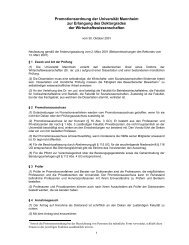The returns to cognitive and non-cognitive abilities in Germany
The returns to cognitive and non-cognitive abilities in Germany
The returns to cognitive and non-cognitive abilities in Germany
You also want an ePaper? Increase the reach of your titles
YUMPU automatically turns print PDFs into web optimized ePapers that Google loves.
a temporary job, a part-time job, <strong>and</strong> another dummy on whether the respondent is a whitecollar<br />
worker. 14<br />
To test for <strong>non</strong>-l<strong>in</strong>earities <strong>in</strong> the relationship between <strong>cognitive</strong> <strong>and</strong> <strong>non</strong>-<strong>cognitive</strong><br />
skills <strong>and</strong> earn<strong>in</strong>gs we follow Mueller <strong>and</strong> Plug (2006) <strong>and</strong> estimate regressions <strong>in</strong>clud<strong>in</strong>g<br />
dummies that <strong>in</strong>dicate whether the <strong>in</strong>dividual’s scores are <strong>in</strong> the <strong>to</strong>p or bot<strong>to</strong>m 25% of the<br />
distribution. This is because us<strong>in</strong>g l<strong>in</strong>ear scores may push the estimated average <strong>returns</strong> <strong>to</strong><br />
zero if for example only moderate openness is rewarded on the labor market but both be<strong>in</strong>g<br />
<strong>to</strong>o open or not be<strong>in</strong>g open at all is punished.<br />
It might further be argued that an employee’s cognition <strong>and</strong> personality are not<br />
observable <strong>to</strong> the employer at the beg<strong>in</strong>n<strong>in</strong>g of an employment relationship but are revealed<br />
over time so that <strong>returns</strong> <strong>to</strong> these traits might vary with tenure (Nyhus <strong>and</strong> Pons, 2005). We<br />
hence estimate additional regressions <strong>in</strong>clud<strong>in</strong>g variables which <strong>in</strong>teract cognition <strong>and</strong><br />
personality <strong>in</strong>dica<strong>to</strong>rs with workers’ tenure. Account<strong>in</strong>g for the differences by gender found<br />
<strong>in</strong> previous research, we run our regressions separately for males <strong>and</strong> females.<br />
4. Results<br />
Pooled cross-sections<br />
Estimates from the pooled OLS regressions as well as from the regressions that<br />
correct for measurement error are provided <strong>in</strong> Table 1. 15 <strong>The</strong>se f<strong>in</strong>d<strong>in</strong>gs do not account for<br />
<strong>in</strong>dividual heterogeneity but are given as benchmark <strong>to</strong> compare our results with prior<br />
f<strong>in</strong>d<strong>in</strong>gs <strong>in</strong> the literature. <strong>The</strong> first issue worth not<strong>in</strong>g is that, as expected, the results <strong>in</strong> the<br />
error-<strong>in</strong>-variables regressions that impose the reliability ratios <strong>in</strong> the estimation mostly<br />
<strong>in</strong>dicate <strong>in</strong>creases <strong>in</strong> the absolute values of the estimated coefficients <strong>and</strong>, if significant, also<br />
<strong>in</strong> the significance level (Table 1, column 2 <strong>and</strong> 4).<br />
19















